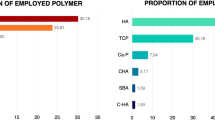Abstract
This article presents a novel rapid layered manufacturing approach based on a combined additive manufacturing (AM) process and a UV-based micro-syringe deposition (μSD) technique to be used in the fabrication of bio-ceramic structures with controlled micro-sized channels for bone and osteochondral tissue regeneration. In the proposed rapid manufacturing method, micro-scale sacrificial photopolymer networks are integrated within the manufactured part by depositing the photopolymer on selected bio-ceramic powder layers using an injection system. This AM–μSD method along with a post-processing protocol can potentially overcome current limitations of traditional powder-based AM approaches that are restricted in terms of complexity of internal architecture and feature size. For bone or osteochondral repair applications, the material system composed of the bio-ceramic and sacrificial photopolymer, along with the post-processing protocol, must ensure that the final implants are free from manufacturing residuals that could trigger an immune response post-implantation. In this study, calcium polyphosphate bio-ceramic was used as the substrate material based on prior art, polyvinyl alcohol solution was used as the powder binding agent, and ethoxylated (10 bisphenol A diacrylate) photopolymer solution was used as the sacrificial photopolymer element. Material characterization suggests that the proposed material system along with heat treatment protocol is suitable for the targeted applications where micro-scale channels within the implant are produced by AM–μSD.
Similar content being viewed by others
References
Hutchinson M (2009) The burden of musculoskeletal diseases in the United States: prevalance, societal and economic cost. J Am Coll Surg 208(1):e5–e6
Gikas PD, Bayliss L, Bentley G, Briggs TWR (2009) An overview of autologous chondrocyte implantation. Bone and Joint Surgery - British Volume 91(8):997–1006
Hutmacher DW (2000) Scaffolds in tissue engineering bone and cartilage. Biomaterials 21(24):2529–2543
Yang S, Leong KF, Du Z, Chua CK (2001) The design of scaffolds for use in tissue engineering. Part I. Traditional factors. Tissue Eng 7(6):679–689
Chang BS, Lee CK, Hong KS, Youn HJ, Ryu HS, Chung SS, Park KW (2000) Osteoconduction at porous hydroxyapatite with various pore configurations. Biomaterials 21(12):1291–1298
Kujala S, Ryhanen J, Danilov A, Tuukkanen J (2003) Effect of porosity on the osteointegration and bone ingrowth of a weight-bearing nickel–titanium bone graft substitute. Biomaterials 24(25):4691–4697
Martin I, Miot S, Barbero A, Jakob M, Wendt D (2007) Osteochondral tissue engineering. Biomechanics 40(4):750–765
Kandel RA, Grynpas M, Pilliar R, Lee J, Wang J, Waldman S, Zalzal P, Hurtig M (2006) Repair of osteochondral defects with biphasic cartilage–calcium polyphosphate constructs in a sheep model. Biomaterials 27(22):4120–4131
Bartel DL, Davy DT, Keaveny TM (2009) Orthopaedic biomechanics—mechanics and design in musculoskeletal systems. Upper Saddle River, Pearson Prentice Hall, pp 110–115
Woesz A, Rumpler M, Stampf J, Varga F, Fratzl-zelman N, Roschger P (2005) Towards bone replacement materials from calcium phosphates via rapid prototyping and ceramic gel casting. Gene 25:181–186
Manjubala I, Woesz A, Pilz C, Rumpler M, Fratzl-zelman N, Roschger P, Stampfl J, Fratzl P (2005) Biomimetic mineral–organic composite scaffolds with controlled internal architecture. Materials Science: Materials in Medicine 6:1111–1119
Lee M, Dunn JCY, Wu BM (2005) Scaffold fabrication by indirect three-dimensional printing. Biomaterials 26(20):4281–4289
Leong K, Cheah C, Chua C (2003) Solid freeform fabrication of three-dimensional scaffolds for engineering replacement tissues and organs. Biomaterials 24(13):2363–2378
Pilliar RM, Filiaggi MJ, Wells JD, Grynpas MD, Kandel RA (2001) Porous calcium polyphosphate scaffolds for bone substitute applications—in vitro characterization. Biomaterials 22(9):963–972
Shanjani Y, Hu Y, Pilliar RM, Toyserkani E (2011) Mechanical characteristics of solid-freeform-fabricated porous calcium polyphosphate structures with oriented stacked layers. Acta Biomaterialia 7(4):1788–1796
Pilliar RM, Kandel RA, Grynpas MD, Zalzal P, Hurtig M (2007) Osteochondral defect repair using a novel tissue engineering approach: sheep model study. Technology and Health Care: Official Journal of the European Society for Engineering and Medicine 15(1):47–56
Grynpas MD, Pilliar RM, Kandel RA, Renlund R, Filiaggi M, Dumitriu M (2002) Porous calcium polyphosphate scaffolds for bone substitute applications in vivo studies. Biomaterials 23(9):2063–2070
Pilliar R, Hong J, Santerre P (2009) Method of manufacture of porous inorganic structures. US Patent 7494614
Shanjani Y, De Croos JNA, Pilliar RM, Kandel RA, Toyserkani E (2010) Solid freeform fabrication and characterization of porous calcium polyphosphate structures for tissue engineering purposes. Biomedical Materials Research Part B Applied Biomaterials 93(2):510–519
German R (1996) Sintering theory and practice, 1st edn. Wiley, New York
Gilman J, Vanderhart D, Kashiwagi T (1995) Thermal-decomposition chemistry of poly(vinyl alcohol)—characterization and reactions with bismaleimides. Fire and Polymers II: Materials and Tests for Hazard Prevention 599:161–185
Author information
Authors and Affiliations
Corresponding author
Rights and permissions
About this article
Cite this article
Vlasea, M., Shanjani, Y., Bothe, A. et al. A combined additive manufacturing and micro-syringe deposition technique for realization of bio-ceramic structures with micro-scale channels. Int J Adv Manuf Technol 68, 2261–2269 (2013). https://doi.org/10.1007/s00170-013-4839-7
Received:
Accepted:
Published:
Issue Date:
DOI: https://doi.org/10.1007/s00170-013-4839-7




